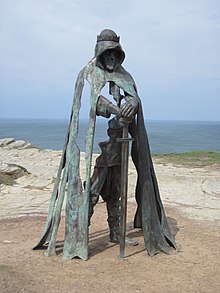Gallos (sculpture)
 The sculpture in 2016 | |
 | |
| 50°40′07.6″N 4°45′48.8″W / 50.668778°N 4.763556°W | |
| Location | Tintagel Castle[1] |
|---|---|
| Designer | Rubin Eynon |
| Material | Bronze |
| Height | 8 ft (2.4 m) |
| Beginning date | 2015 |
| Opening date | 29 April 2016 |
| Website | Website |
Gallos is an 8-foot-tall (2.4 m) bronze sculpture by Rubin Eynon located at Tintagel Castle, a medieval fortification located on the peninsula of Tintagel Island adjacent to the village of Tintagel (Trevena), North Cornwall, in the United Kingdom. It is a representation of a ghostly male figure wearing a crown and holding a sword. It is popularly called the "King Arthur statue", but the site's owner English Heritage states that it is not meant to represent a single person and reflects the general history of the site, which is likely to have been a summer residence for the kings of Dumnonia.
Background

Tintagel Castle is sited on the north coast of Cornwall, and is operated by English Heritage.[2] The writings of Geoffrey of Monmouth in the 12th century associated the castle with the King Arthur legend, placing it as the home of Arthur's mother Igraine. The castle itself was constructed by Richard, Earl of Cornwall in the 1230s; inspired by the association with Arthur, he had the castle styled to appear older. It was expanded in the Victorian era.[3][4]
Sculpture
Gallos was commissioned by English Heritage from the sculptor Rubin Eynon, [2][5] It took six months to design, sculpt and cast.[3] Gallos portrays a figure 8 ft (2.4 m) tall in a cloak, resting on a sword and wearing a crown.[4] The figure at Tintagel Castle is only partly rendered, with open gaps left in the sculpture through which the viewer can see the landscape beyond, giving a spectral appearance.[6]
The sculpture has become a popular attraction at the castle site.
Location and installation

The statue is located above cliffs on the Atlantic coast-side of the castle.
The sculpture was installed by English Heritage as part of a new visitor experience on the site.[9] An earlier sculpture, a rock carving depicting Merlin, had been criticised by Cornish nationalists and historians for "Disneyfication" of the history of the site, and Gallos also raised similar questions.[4][9]
The scheme also saw the installation of a stone compass pointing to other locations across the British Isles associated with the Arthurian legends and stepping stones in the castle garden telling the story of
References
- ^ Schaap, Rosie (June 27, 2017). "The Weird, Mystic Pull of Southwest England". The New York Times. Archived from the original on December 5, 2021. Retrieved December 5, 2021.
- ^ a b c d "History meets Legend at Tintagel Castle". English Heritage. Archived from the original on December 10, 2021. Retrieved December 10, 2021.
- ^ a b c d "Gallos – King Arthur Sculpture". Cornwall Guide. January 27, 2021. Archived from the original on December 10, 2021. Retrieved December 10, 2021.
- ^ a b c d e f g h i Morris, Steven (April 24, 2016). "Kingly statue plunges sword into Tintagel's Arthurian row". The Guardian. Archived from the original on December 5, 2021. Retrieved December 10, 2021.
- ^ a b c Stewart, Jessica (May 9, 2017). "8-Foot-Tall Bronze Sculpture of King Arthur Overlooks the Atlantic Ocean". My Modern Met. Archived from the original on December 5, 2021. Retrieved December 10, 2021.
- ^ a b Smith, Graham (August 22, 2017). "What do you think of Gallos, the new sculpture at Tintagel Castle?". CornwallLive. Archived from the original on December 10, 2021. Retrieved December 10, 2021.
- ISBN 978-1789695274. Archivedfrom the original on January 21, 2022. Retrieved December 5, 2021.
- ISBN 978-1789044621. Archivedfrom the original on January 21, 2022. Retrieved December 5, 2021.
- ^ a b c "Controversial King Arthur statue revealed at Tintagel". ITV News. April 25, 2016. Archived from the original on December 10, 2021. Retrieved December 10, 2021.
External links
 Media related to Gallos (sculpture) at Wikimedia Commons
Media related to Gallos (sculpture) at Wikimedia Commons
